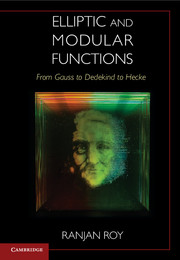Book contents
- Frontmatter
- Contents
- Preface
- 1 The Basic Modular Forms of the Nineteenth Century
- 2 Gauss's Contributions to Modular Forms
- 3 Abel and Jacobi on Elliptic Functions
- 4 Eisenstein and Hurwitz
- 5 Hermite's Transformation of Theta Functions
- 6 Complex Variables and Elliptic Functions
- 7 Hypergeometric Functions
- 8 Dedekind's Paper on Modular Functions
- 9 The η Function and Dedekind Sums
- 10 Modular Forms and Invariant Theory
- 11 The Modular and Multiplier Equations
- 12 The Theory of Modular Forms as Reworked by Hurwitz
- 13 Ramanujan's Euler Products and Modular Forms
- 14 Dirichlet Series and Modular Forms
- 15 Sums of Squares
- 16 The Hecke Operators
- Appendix: Translation of Hurwitz's Paper of 1904
- Bibliography
- Index
Preface
Published online by Cambridge University Press: 20 April 2017
- Frontmatter
- Contents
- Preface
- 1 The Basic Modular Forms of the Nineteenth Century
- 2 Gauss's Contributions to Modular Forms
- 3 Abel and Jacobi on Elliptic Functions
- 4 Eisenstein and Hurwitz
- 5 Hermite's Transformation of Theta Functions
- 6 Complex Variables and Elliptic Functions
- 7 Hypergeometric Functions
- 8 Dedekind's Paper on Modular Functions
- 9 The η Function and Dedekind Sums
- 10 Modular Forms and Invariant Theory
- 11 The Modular and Multiplier Equations
- 12 The Theory of Modular Forms as Reworked by Hurwitz
- 13 Ramanujan's Euler Products and Modular Forms
- 14 Dirichlet Series and Modular Forms
- 15 Sums of Squares
- 16 The Hecke Operators
- Appendix: Translation of Hurwitz's Paper of 1904
- Bibliography
- Index
Summary
Modular function theory has developed a great deal during the past two hundred years, and its foundations have been reworked several times. During the course of this process, some earlier approaches and methods have naturally fallen into disuse or obscurity. The purpose of this work is to present the fundamental results of modular function theory as developed during the nineteenth and early twentieth centuries, focusing particularly on those interesting methods and techniques that appear to have been overlooked or are not generally well known.While the study of these methods has intrinsic value, it may also be useful to contemporary researchers in modular function theory. The study of nineteenth-century mathematics is often believed to be quite cumbersome, but a little familiarity with its mode of presentation and context readily dissolves much of this obstacle. To illustrate this point, I have remained very close to the original expositions and have provided some details about the creators of modular function theory. It is my hope that substantial portions of this book will be accessible to beginning graduate students, and to undergraduates with a solid knowledge of complex analysis.
The triple product identity is the expression of a theta series as an infinite product, and by 1808 this identity was known to Gauss; Chapter 2 is devoted to Gauss's work on theta functions. A special case of the triple product identity, known as the pentagonal number theorem, was conjectured by Euler in 1741 and proved by him in 1750. This theorem is so named because the powers of the variable in the series are pentagonal numbers. Euler proved this result by a very interesting and fruitful method, and Gauss, perhaps around 1796–97, showed that the method could also be applied to the situation in which the powers were squares or triangular numbers. This work of Gauss has received hardly any attention. In 1882, Cayley applied this method to reprove an important identity of Sylvester. Again, in 1919, Ramanujan employed it to prove the Rogers-Ramanujan identity. More recently, Andrews has shown that Euler's method can be applied to verify several significant q-series identities.
Jacobi's fundamental results on infinite products for the Jacobi elliptic functions are discussed in Chapter 3. These infinite products may be obtained in several ways, one due to Abel; most expositions use the method of theta functions, found by Jacobi.
- Type
- Chapter
- Information
- Publisher: Cambridge University PressPrint publication year: 2017



